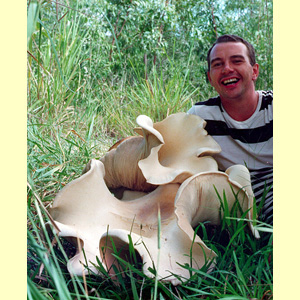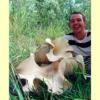
images/Macrocybe_crassa/Macrocybe_152hv01.jpg


Diagnostic characters
Large to very large agaric (pileus to 480 mm diameter), growing on the ground, with a cream spore print. Pileus pale or brown, dry or moist. Lamellae adnexed or sinuate or notched, white or pale. Stipe central or excentric. Partial veil remnants absent. Spores hyaline, non-amyloid, smooth; germ pore absent. Cheilocystidia absent. Lamellar trama regular. Pileipellis a cutis. Clamp connections present.
Similar genera
This is one of the largest agarics in Australia. Cortinarius australiensis can reach similar dimensions, but it has a well-developed annulus and a brown spore print. Some species of Tricholoma are large, but they lack clamp connections, and they also can have an annulus, or a more strongly coloured pileus. Some larger species of Lyophyllum grow in clusters, and can be very similar in appearance to Macrocybe, but they have siderophilous granulation in the basidia. Macrocybe has only been reported from Queensland, whereas Lyophyllum is widespread.
Citation
Macrocybe Pegler & Lodge, in Pegler et al., Mycologia 90: 496 (1998).
Australian species
One species: Macrocybe crassa.
Citation of species
Macrocybe crassa (Berk.) Pegler & Lodge in Pegler et al., Mycologia 90: 497 (1998).
Australian distribution
Qld (and possibly also N.T. and northern N.S.W.).
Habitat
Habitat not known.
Substrate
On the ground.
Trophic status
Saprotrophic.
References
Pegler, D.N. (1986), Agaric flora of Sri Lanka, Kew Bull., Addit. Ser. 12: 1–519. [Description and Microcharacters of M. crassa as Tricholoma, but including M. pachymeres (as Tricholoma) as a synonym, which differs in the squamulose stipe]
Pegler, D.N. (1997), The Larger Fungi of Borneo. Natural History Publications, Kota Kinabalu. [Illustration of M. crassa from Borneo]
Pegler, D.N., Lodge, D.J. & Nakasone, K.K. (1998), The pantropical genus Macrocybe gen. nov., Mycologia 90: 497–504. [Key to species of the genus, and Description and Microcharacters of M. crassa, and other known species]
Young, T. (1998a), The giant agaric Tricholoma crassus (Berk.) Sacc. reappears in Queensland, Australas. Mycol. Newslett.. 17: 25–26. [Description and B&W Illustration of M. crassa (as Tricholoma)]
